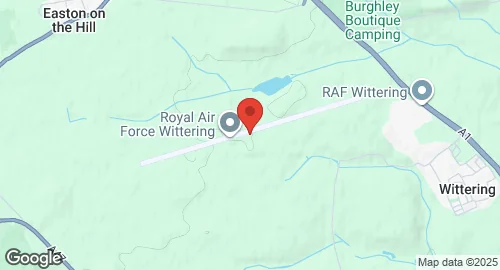RAF Wittering
Summary
| Operating Country | 🇬🇧 United Kingdom |
| Location | 🇬🇧 United Kingdom |
| Status | ◉ Active |
| Usage | Military only |
| Year built | 1916 |
| Operating Organization | Royal Air Force |
| Units |
|
Description
RAF Wittering is a Royal Air Force air combat support station located in Cambridgeshire, England. Its use as a military airfield dates back to 5 May 1916, when it began as RFC Stamford, initially for A Flight of No. 38 (Home Defence) Squadron for training and anti-Zeppelin patrols. It was renamed RAF Wittering on 10 April 1918. The station officially reopened in 1924 after an Air Defence Review and served as the Central Flying School and No. 11 Flying Training School during the interwar period. In April 1938, it became a Fighter Command station within No. 12 Group, undergoing significant expansion.
During the Second World War, RAF Wittering was active in the Battle of Britain and the Blitz, serving as a main fighter station. It hosted various squadrons, including No. 141 Squadron with de Havilland Mosquitoes, and temporarily hosted USAAF squadrons. The airfield was bombed five times, resulting in seventeen fatalities on 14 March 1941. It also became home to fighter and gunnery research and development units and No. 1426 (Captured Enemy Aircraft) Flight, which evaluated captured Luftwaffe aircraft.
Post-war, RAF Wittering transferred to Bomber Command in 1953, becoming a vital part of the UK's strategic nuclear deterrent during the Cold War. It operated Avro Lincolns, English Electric Canberras, and V-bombers (Vickers Valiant, Handley Page Victor, and Avro Vulcan). The first British operational atomic bomb, the Blue Danube, was deployed here in November 1953. From 1962 to 1968, No. 100 Squadron and No. 139 Squadron operated Victor B2 bombers equipped with Blue Steel missiles as part of the Quick Reaction Alert (QRA) force.
From 1968, the station was known as the 'Home of the Harrier', with the first Harriers arriving for No. 1 (Fighter) Squadron in August 1969. Harriers from Wittering played a role in the Falklands War in 1982. The Harrier fleet was withdrawn in December 2010 as a result of the 2010 Strategic Defence and Security Review.
Currently, RAF Wittering is an operational air combat support station controlled by No. 2 Group (Air Combat Support). It is the home of the RAF Support Force, which includes the Royal Air Force's engineering and logistic Air Combat Service Support Units (ACSSUs). It hosts Headquarters and elements of No. 42 (Expeditionary Support) Wing and No. 85 (Expeditionary Logistics) Wing, along with their constituent squadrons (No. 71 (Inspection and Repair) Squadron, No. 93 (Expeditionary Armament) Squadron, No. 5001 Squadron, No. 1 Expeditionary Logistics Squadron, No. 2 Mechanical Transport Squadron, No. 3 Mobile Catering Squadron, No. 504 (County of Nottingham) Squadron Royal Auxiliary Air Force). The station also supports flying training, hosting No. 16 Squadron, No. 115 Squadron, Cambridge University Air Squadron, University of London Air Squadron, and No. 5 Air Experience Flight, all operating Grob Tutor T1 aircraft. Additionally, elements of the Royal Engineers, including Headquarters 12 (Force Support) Engineer Group and 20 Works Group (Air Support), are based at RAF Wittering.
